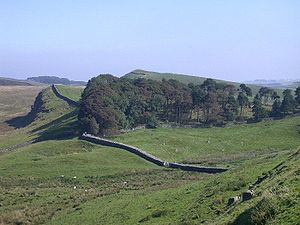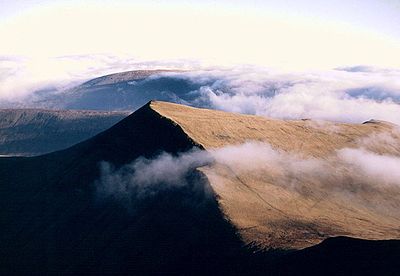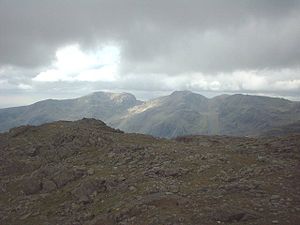
National parks of England and Wales
Background to the schools Wikipedia
This Wikipedia selection is available offline from SOS Children for distribution in the developing world. See http://www.soschildren.org/sponsor-a-child to find out about child sponsorship.
The national parks of England and Wales are areas of relatively undeveloped and scenic landscape that are designated under the National Parks and Access to the Countryside Act 1949. Despite the name, national parks in England and Wales are quite different from those in many other countries, where national parks are owned and managed by the government as a protected community resource, and permanent human communities are not a part of the landscape. In England and Wales, designation as a national park can include substantial settlements and land uses which are often integral parts of the landscape, and land within a national park remains largely in private ownership.
There are currently 12 national parks ( Welsh: parciau cenedlaethol) in England and Wales. A further area in England — the South Downs — is in the process of being designated as a national park. Each park is operated by its own National Park Authority, with two "statutory purposes":
- to conserve and enhance the natural beauty, wildlife and cultural heritage of the area, and
- to promote opportunities for the understanding and enjoyment of the park's special qualities by the public.
An estimated 110 million people visit the national parks of England and Wales each year. Recreation and tourism bring visitors and funds into the parks, to sustain their conservation efforts and support the local population through jobs and businesses. These visitors also bring problems, such as erosion and traffic congestion, and conflicts over the use of the parks' resources.
History
Untamed countryside
Archaeological evidence from prehistoric Britain shows that the areas now designated as national parks have been occupied by humans since the Stone Age, at least 5,000 years ago and in some cases much earlier.
Before the 19th century, relatively wild, remote areas were often seen simply as uncivilised and dangerous. In 1725 Daniel Defoe described the High Peak as "the most desolate, wild and abandoned country in all England". However, by the early 19th century, romantic poets such as Byron, Coleridge and Wordsworth wrote about the inspirational beauty of the "untamed" countryside. Wordsworth described the Lake District as a "sort of national property in which every man has a right and interest who has an eye to perceive and a heart to enjoy" in 1810. This early vision took over a century, and much controversy, to take legal form in the UK with the National Parks and Access to the Countryside Act 1949.
The idea for a form of national parks was first proposed in the United States in the 1860s, where National Parks were established to protect wilderness areas such as Yosemite. This model has been used in many other countries since, but not in the United Kingdom. After thousands of years of human integration into the landscape, Britain lacks natural areas of wilderness. Furthermore, those areas of natural beauty so cherished by the romantic poets were often only maintained and managed in their existing state by human activity, usually agriculture.
Government support is established
By the early 1930s, increasing public interest in the countryside, coupled with the growing and newly mobile urban population, was generating increasing friction between those seeking access to the countryside and landowners. Alongside of direct action trespasses, such as the mass trespass of Kinder Scout, several voluntary bodies took up the cause of public access in the political arena.
In 1931, Christopher Addison (later Lord Addison) chaired a government committee that proposed a 'National Park Authority' to choose areas for designation as national parks. A system of national reserves and nature sanctuaries was proposed:
- "(i) to safeguard areas of exceptional natural interest against (a) disorderly development and (b) spoliation; (ii) to improve the means of access for pedestrians to areas of natural beauty; and (iii) to promote measures for the protection of flora and fauna."
However, no further action was taken after the intervention of the 1931 General Election.
The voluntary Standing Committee on National Parks first met on 26 May 1936 to put the case to the government for national parks in the UK. After World War II, the Labour Party proposed the establishment of national parks as part of the post-war reconstruction of the UK. A report by John Dower, secretary of the Standing Committee on National Parks, to the Minister of Town and Country Planning in 1945 was followed in 1947 by a Government committee, this time chaired by Sir Arthur Hobhouse, which prepared legislation for national parks, and proposed 12 national parks. Sir Arthur had this to say on the criteria for designating suitable areas:
| “ | The essential requirements of a National Park are that it should have great natural beauty, a high value for open-air recreation and substantial continuous extent. Further, the distribution of selected areas should as far as practicable be such that at least one of them is quickly accessible from each of the main centres of population in England and Wales. Lastly there is merit in variety and with the wide diversity of landscape which is available in England and Wales, it would be wrong to confine the selection of National Parks to the more rugged areas of mountain and moorland, and to exclude other districts which, though of less outstanding grandeur and wildness, have their own distinctive beauty and a high recreational value. | ” |
National Parks and Access to the Countryside Act 1949

The National Parks and Access to the Countryside Act 1949 was passed with all party support. The first 10 national parks were designated as such in the 1950s under the Act in mostly poor-quality agricultural upland. Much of the land was still owned by individual landowners, often private estates, but there was also property owned by public bodies such as the Crown, or charities which allow and encourage access such as the National Trust. Accessibility from the cities was also considered important.
Other areas were also considered: for example, parts of the coast of Cornwall were considered as a possible national park in the 1950s but were thought to be too disparate to form a single coherent national park and were eventually designated as an Area of Outstanding Natural Beauty (AONB) instead. The north Pennines were also considered for designation as a national park in the 1970s but the proposal was thought to be administratively too difficult because the area was administered by 5 different county councils.
Later additions
The Broads in East Anglia are not in the strictest sense a national park, being run by a separately constituted Broads Authority set up by a special Act of Parliament in 1988 and with a structure in which conservation is subordinate to navigational concerns (see Sandford Principle below), but it is generally regarded as being "equivalent to" a national park.
The New Forest, which includes the largest remaining tracts of unenclosed pasture land, heathland and old-growth forest in the heavily-populated south east of the country, was designated as a national park on March 1, 2005.
A further national park in the South Downs is proposed, and received support from the government in September 1999. The South Downs is the last of the 12 areas chosen in the 1947 Hobhouse Report yet to become a national park. As of February 2005, a public inquiry is being held to decide the boundaries of the proposed national park. The Inquiry sat for 90 days in 2004 before being formally closed on 23 March 2005. Defra issued information for public consultation on 2 July 2007, and may decide to reopen the South Downs public inquiry in late 2007. The CPRE is also currently campaigning for the South Downs to receive national park status.
Organisation
Following the Environment Act 1995, each national park has been managed by its own National Park Authority since April 1997. Previously, all but the Peak District and the Lake District were governed by the local county councils. The Peak District and the Lake District, the first two national parks to be designated, were under the control of Planning Boards that were independent of the local county councils.
Each Authority is required to carry out two "statutory purposes":
- to conserve and enhance the natural beauty, wildlife and cultural heritage of the area; and
- to promote opportunities for the understanding and enjoyment of the parks' special qualities by the public.
These purposes can conflict: in such cases, under the " Sandford Principle", conservation comes first. This principle was given statutory force by section 62 of the Environment Act 1995. In pursuing these purposes, National Park Authorities also have a duty to foster the social and economic well-being of their local communities.
Slightly over half the members of each National Park Authority are appointees from the Principal Local Authorities covered by the park; the remainder are appointed by the Secretary of State for Environment, Food and Rural Affairs, some to represent local parish councils, others selected to represent the "national interest". The Broads Authority also has members appointed by the Countryside Agency, English Nature, Great Yarmouth Port Authority and the Environment Agency. The National Park and Broad Authorities are covered by similar regulatory controls to those applied to local councils.
Funding for national parks is complex, but the full cost of each Park Authority is funded from central government funds. In the past this was partly paid for by local authorities, and refunded to them from the government to varying degrees. In 2003/2004, the Park Authorities received around £35.5 million of central government funding.
The Countryside Agency and the Countryside Council for Wales are the statutory bodies responsible for designating new national parks, subject to approval by the Secretary of State. The Association of National Park Authorities exists to provide the Park Authorities with a single voice when dealing with government and its agencies. The Campaign for National Parks (formerly Council for National Parks) is a charity that works to protect and enhance the national parks of England and Wales.
Planning in national parks
National Park Authorities are strategic and local planning authorities for their areas. They are responsible for maintaining the Local Development Framework — the spatial planning guide for their area. They also grant planning consent for development, within the constraints of the Framework. This gives them very considerable direct control over residential and industrial development, and the design of buildings and other structures; as well as strategic matters such as mineral extraction.
The National Park Authorities' planning powers vary only slightly from other authorities, but the policies and their interpretation are stricter than elsewhere. This is supported and encouraged by the Government who regard:
- "National Park designation as conferring the highest status of protection as far as landscape and scenic beauty are concerned." The Countryside — Environmental Quality and Economic and Social Development (1997)
Contribution to the local economy
Tourism is an important part of the economy of National Parks. Through attractions, shops and accommodation, visitors provide an income and a livelihood to local employers and farmers. This income provides jobs for the park. For example, within the Peak District National Park the estimate in 2004 for visitor spending is £185 million, which supports over 3,400 jobs, representing 27% of total employment in the National Park.
Conflicts in national parks
The National Park Authorities have two roles: to conserve and enhance the park, and to promote its use by visitors. These two objectives cause frequent conflicts between the needs of different groups of people. It is estimated that the national parks of England and Wales receive 110 million visitors each year. Although recreation and tourism brings many benefits to an area, it also brings a number of problems. The national funding offered to National Park Authorities is partly in recognition of the extra difficulties created in dealing with these conflicts.
- Congestion of villages and beauty spots
- Some of the most popular " honeypot" areas attract large numbers of visitors, resulting in overcrowded car parks, blocked roads, and overstretched local facilities, particularly on Sundays in the summer and on bank holidays. Examples include the areas near Keswick in the Lake District and Buxton and Bakewell in the Peak District.
- Erosion
- Walking and use of other public rights-of-way is an extremely popular use of all the national parks. Heavy use of the most popular paths leads to considerable erosion, but strengthening of paths can be unsightly. Particularly heavy wear is caused by sponsored walks, walks promoted by national books and magazines, by horse riding on unsurfaced bridleways, and use of off-road vehicles on green lanes. Examples include Dovedale in the Peak District. Over-grazing, for example, by sheep on hill and moorland areas, can also reduce vegetation, leading to increased erosion.
- Damage and disturbance to wildlife
- Wildlife may be disturbed by the level of use on some of the areas of the parks that are open to the public. Moorland and chalk downland is easily damaged by regular use, and takes many years to recover. Moorland birds in particular nest and roost on the ground and are therefore especially sensitive. Orienteering, mountain biking and hang gliding are typical activities which are likely to cause disturbance to nesting birds.
- Litter
- Litter of all kinds is both unsightly and can cause pollution and damage to livestock and wild animals. Broken glass is a danger to people and, by focusing the rays of the sun, a possible cause of fire, particularly in areas of moorland such as Exmoor, parts of the Peak District and the North York Moors.
- Damage to farmland
- Trampling of grass meadows reduces the amount of winter feed for farm animals. Walkers who stray from footpaths may climb over fences or dry stone walls rather than looking out for the stiles that mark the course of footpaths across farmland. Sheep can be injured or even killed by dogs not under proper control, especially at lambing time.
- Local community displacement
- Gift shops and cafés which cater for the needs of tourists are often more profitable than shops selling everyday goods for local people (such as butchers or bakers). In some villages where tourist shops are in the majority and there are few shops catering for the local people, the local community may feel pushed out by the tourists. Houses are often very expensive in tourist villages as there is demand for them as second homes or holiday homes by holiday cottage firms or well-off people who live elsewhere, or who move to a local home from which they commute to work, making them unaffordable for local people. This is a particular problem in areas within easy commuting distance of large cities, such as the Peak District, the Lake District, the Yorkshire Dales, and the New Forest.
- Conflict between recreational users
- Some forms of use of national parks interfere with other uses. For example, use of high-speed boats causes noise pollution, and conflicts with other uses such as boat trips, yachting, canoeing, and swimming. A controversial bylaw imposing a 10 miles per hour speed limit came into force on Windermere on 29 March 2005. The new speed limit for Windermere effectively prohibits speedboats and water skiing in the Lake District (of the 16 larger lakes in the Lake District, only Windermere, Coniston Water, Derwent Water and Ullswater have a public right of navigation; speed limits were imposed on the three lakes other than Windermere in the 1970s and 1980s).
List of national parks
|
|||||||||||||||||||||||||||||||||||||||||||||||||||||||||||||||||
At the beginning of 2005, some 9.3% of the area of England and Wales lay within national parks; the addition of South Downs and the New Forest would raise this to 10.7%. The three national parks in Wales cover around 20% of the land area of Wales.



